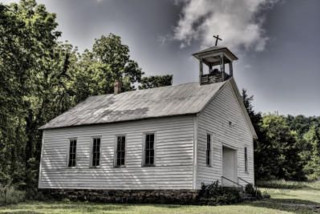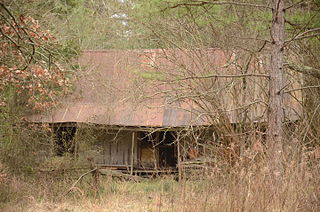Elliott House or Elliot House may refer to:
Samuel Brown House may refer to:

The Farrell Houses are a group of four houses on South Louisiana Street in Little Rock, Arkansas. All four houses are architecturally significant Bungalow/Craftsman buildings designed by the noted Arkansas architect Charles L. Thompson as rental properties for A.E. Farrell, a local businessman, and built in 1914. All were individually listed on the National Register of Historic Places for their association with Thompson. All four are also contributing properties to the Governor's Mansion Historic District, to which they were added in a 1988 enlargement of the district boundaries.

The Governor's Mansion Historic District is a historic district covering a large historic neighborhood of Little Rock, Arkansas. It was listed on the National Register of Historic Places in 1978 and its borders were increased in 1988 and again in 2002. The district is notable for the large number of well-preserved late 19th and early 20th-century houses, and includes a major cross-section of residential architecture designed by the noted Little Rock architect Charles L. Thompson. It is the oldest city neighborhood to retain its residential character.

Remmel Apartments and Remmel Flats are four architecturally distinguished multiunit residential buildings in Little Rock, Arkansas. Located at 1700-1710 South Spring Street and 409-411 West 17th Street, they were all designed by noted Arkansas architect Charles L. Thompson for H.L. Remmel as rental properties. The three Remmel Apartments were built in 1917 in the Craftsman style, while Remmel Flats is a Colonial Revival structure built in 1906. All four buildings are individually listed on the National Register of Historic Places, and are contributing elements of the Governor's Mansion Historic District.
Copeland House may refer to:

West Richwoods is an unincorporated community in Stone County, Arkansas, United States. West Richwoods is located on Arkansas Highway 9, 4.2 miles (6.8 km) southwest of Mountain View. The Samuel Brown House and the West Richwoods Church & School, which are both listed on the National Register of Historic Places, are located in West Richwoods.

The Mahony Historic District encompasses a residential part of El Dorado, Arkansas north of its downtown area. It was an area of significant development in the years after the 1921 discovery of oil and the ensuing economic boom. The area is bounded on the south by Champagnolle Road, on the west by a line just east of North Madison Avenue, on the north by East 5th Street, and on the east by North Lee Avenue and railroad tracks. It is just over 14 acres (5.7 ha) in size, and includes 94 buildings that contribute to its significance. The streets in the district are laid out in grid form, accounting for the fact that Champagnolle Road runs diagonally from southwest to northeast. Most of the housing in the district consists of modest single-story houses, with simple styling. This is a contrast to the adjacent Murphy-Hill Historic District, a more affluent area with a longer history of development. Only five houses in the district were built before 1920, and all lie on Champagnolle Road; most of the rest were built in the decade after the oil discovery. There is one church in the district, St. Mary's Episcopal Church, completed in 1950. The district was listed on the National Register of Historic Places in 2011.

The Dr. Boaz House is a historic house in rural western Clark County, Arkansas. It is located on the south side of Arkansas Highway 26, just west of its junction with County Road 291, near the hamlet of Clear Spring. The dog trot house was probably built c. 1891 by Samuel Peeples as a wedding present for his daughter Annie and Doctor A. Boaz. The house is entirely vernacular in style, and is sheathed primarily in board-and-batten siding. The northern (front) facade has a porch extending its full width, with a chimney on the exterior of the western wall. A kitchen ell extends to the rear (southward) of the western portion of the main block. The house is the finest known instance of the vernacular dog trot form in Clark County.

The Old Alexander House is a historic house on the campus of Southern Arkansas University in Magnolia, Arkansas. Originally built in rural Columbia County in 1855 by Samuel Alexander, this single-story dogtrot house is one of the oldest buildings in the county, and one of its few surviving antebellum structures.

The Alfrey-Brown House is a historic house located at 1001 South Washington Street in Siloam Springs, Arkansas, United States.

The Col. Samuel W. Peel House is a historic house museum, also known as the Peel Mansion Museum, at 400 South Walton Boulevard in Bentonville, Arkansas. It is a two-story stuccoed brick masonry structure, with a three-story hip-roofed tower at the center of its front facade. The house was built c. 1875 by Samuel W. Peel, a prominent local politician and businessman. After serving in the Confederate Army in the American Civil War, Peel studied law and practiced for many years in Bentonville. He served several terms in the United States Congress, and helped establish the First National Bank of Bentonville. Despite later alterations, the house is one of the finest Italianate mansions in the region.

The Wyatt House is a historic house at Gainer Ferry Road and Arkansas Highway 25 in Desha, Arkansas. It is a two-story I-house, three bays wide, with a side gable roof, end chimneys, and a single-story ell extending to the rear. The oldest portion of the house, its first floor, was built about 1870 as a dogtrot. In about 1900, the breezeway of the dogtrot was enclosed, and the second story and ell were added. The property also includes a stone wellhouse dating to the enlargement. The house was built by Samuel Wyatt, a veteran of the American Civil War.

The Fordyce–Ricks House Historic District encompasses a locally rare collection of Adirondack Architecture structures located at 1501 Park Avenue in Hot Springs, Arkansas. The district encompasses 37 acres (15 ha) of land that originally belonged to Samuel W. Fordyce, a prominent railroad executive who had a major role in promoting and developing Hot Springs as a resort community. The district includes a 1 1⁄2-story octagonal log house, three outbuildings, and a landscaped rustic environment. 20 acres (8.1 ha) of the former estate are now a part of Hot Springs National Park.

The Floyd B. Brown House is a historic house at 1401 South Georgia Street in Pine Bluff, Arkansas. It is a single-story vernacular brick structure, with a gable roof and brick foundation. Decorative elements on the building are minimal, with scalloped trim elements at the gables and eaves, and a fanlight in the front-facing gable. The house was built in 1954 for Floyd and Lillian Brown. The Browns were prominent African-American educators: Floyd Brown founded the Fargo Training School in Fargo, Arkansas, and his wife Lillian taught there.

The Samuel D. Byrd Sr. Homestead is a historic farmstead at 15966 United States Route 270, near Poyen, Arkansas. The main house of the farmstead is a single story dogtrot structure, with one log pen built in 1848, and a second pen built out of pine planking in 1850, with a gabled roof covering both pens and the breezeway between. The building has been added to several times, and some of its porches enclosed, to accommodate large families. It was occupied by members of the Byrd family until 2000, and is one of the county's oldest surviving structures.

The Elms is a historic plantation house in rural Jefferson County, Arkansas. Located a short way south of Altheimer, it is a 1-1/2 story raised Louisiana cottage, an architectural form that is extremely rare in Arkansas. It is a 1-1/2 story wood frame structure, set on a raised basement. A porch extends across the front, with jigsawn balustrade, and the main roof is pierced by three gabled dormers. The house was built in 1866 by Dr. Samuel Jordon Jones. It is presently used as a hunting lodge.

The Earl and Oza Crownover-Brown House is a historic house at 133 South Broadway in Damascus, Arkansas. It is a single story masonry structure, built out of sandstone with cream-colored brick trim. It has a side gable roof, with front cross gable and a central entrance topped by a small gable, with a chimney to the door's left. The house was built 1943 by Silas Owen, Sr., a local master mason, and is one of the finest examples of his work.

The Robinson Historic District encompasses the oldest residential neighborhood of Conway, Arkansas. It is located just west of the city's downtown business district, and is bounded on the east by Faulkner Street, the south by Robinson Avenue, the west by Watkins Street, and the north by Ash, Caldwell, and Davis Streets. It contains a cross-section of residential architectural styles covering the city's development between 1890 and 1950. The district is named for Asa P. Robinson, Conway's founder.

Plummer's Station is a historic house on Gap Creek south of Plumerville in Conway County, Arkansas. Built about 1830 and altered several times since, it is one of the oldest surviving structures in the county. At its core is a log cabin, built by Samuel Plummer, and served as a stop on the stagecoach route between Little Rock and Fort Smith in the 19th century. The building is currently falling apart due to a lack of funding to repair it. As it sits this historical site will not last much longer. In appearance it is now an L-shaped single-story structure, sheathed in clapboards.


















